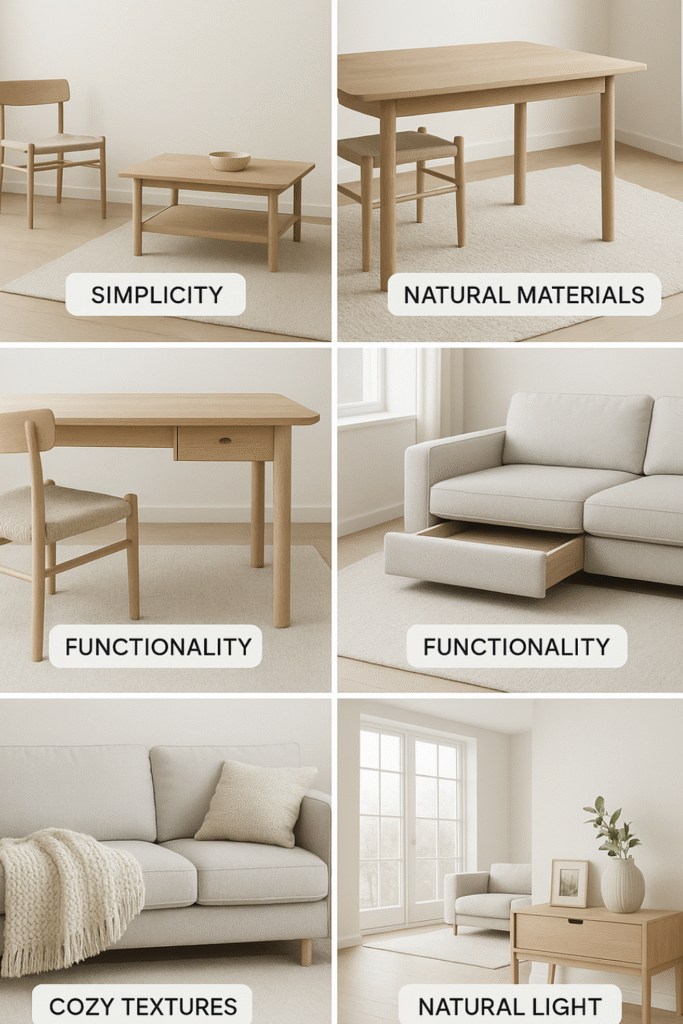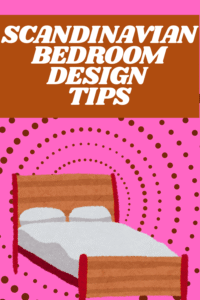If you’re someone who craves clean lines, minimalistic elegance, and cozy vibes, then Scandinavian design might just be the perfect fit for your home. The Nordic countries are known for their simplicity, functionality, and warmth a trifecta that has influenced modern interior design trends worldwide.
But what exactly makes Scandinavian design so appealing, and how can you bring this beautiful style into your home?
In this blog post, I’m going to break down everything you need to know about creating a Scandinavian-inspired space that’s not only stylish but also practical.
I’ll share tips, design principles, and common mistakes to avoid, making sure you have everything you need to achieve that cozy and minimalist Scandinavian look.
So, if you’re ready to transform your home into a sanctuary filled with light, warmth, and style, keep reading.

The Core Principles of Scandinavian Design
Scandinavian design is built on simplicity and functionality, with an emphasis on natural beauty and minimalism.
Originating from Denmark, Sweden, Norway, and Finland, this design style is inspired by the environment think long winters, crisp air, and the beauty of nature. Let’s break down the core principles.
1. Simplicity
The Scandinavian design focuses on simplicity. It’s not about cluttering your space with unnecessary decorations or furniture pieces. Instead, every item in a Scandinavian home is there for a reason – whether it’s for its functionality or its aesthetic appeal.
2. Natural Materials
Natural materials are a hallmark of Scandinavian design. Wood, especially light-colored woods like pine or birch, is widely used in furniture, flooring, and accents. In addition to wood, you’ll also find elements like stone, leather, and wool that connect the design to nature.
3. Neutral Color Palette
One of the first things you’ll notice in a Scandinavian-designed space is its calm, neutral color palette. White, gray, beige, and muted tones dominate the walls, furniture, and decor. These colors help create a serene environment, making the space feel airy and open.
4. Functionality
Functionality is key in Scandinavian homes. Furniture pieces are designed with purpose, focusing on making the most of the space while maintaining a sleek and elegant appearance. Multi-functional furniture, like foldable tables or sofa beds, are common in smaller Scandinavian apartments.
5. Natural Light
Living in Nordic countries, where winter days are often long and dark, Scandinavian designers place a strong emphasis on bringing in as much natural light as possible. Large windows, open spaces, and light-colored walls work together to maximize the daylight that filters in.
Key Elements of Scandinavian Design
Now that we understand the core principles, let’s dive into the key elements that define Scandinavian design. Incorporating these into your home will help you achieve the cozy, functional, and beautiful aesthetic you’re after.
1. Clean Lines and Minimalism
As I mentioned before, Scandinavian design loves clean lines. Furniture tends to have sleek, straight edges, and the focus is on functionality over ornamentation. Think about how every piece in your home serves a purpose. In Scandinavian homes, even the décor is minimal but impactful.
2. Cozy Textures
While Scandinavian design is minimalist, it doesn’t lack warmth. To balance the clean and simple look, cozy textiles like wool throws, sheepskin rugs, and plush cushions are added. The goal is to create a space that’s inviting, not sterile.
3. Nature-Inspired Accents
You’ll often find nature-inspired accessories and decor in Scandinavian homes. Houseplants, wooden furniture, and nature-themed prints or paintings add life to the otherwise neutral palette. Incorporating natural elements creates a calming atmosphere that feels connected to the outdoors.
4. Scandi Lighting
Lighting plays a huge role in Scandinavian homes. In places where the sun barely sets during the summer and barely rises during the winter, having the right lighting can make all the difference. Scandinavian homes use pendant lights, floor lamps, and table lamps with simple, clean designs. A large statement chandelier may be used to add elegance to the space without overwhelming it.
Key Elements of Scandinavian Design
| Element | Description | Example |
| Simplicity | Focus on minimalism and functionality. Less is more. | Clean-lined furniture, open space with few decor items. |
| Natural Materials | Use of natural elements such as wood, stone, leather, and wool. | Light wood furniture, wool blankets, leather chairs. |
| Neutral Color Palette | A calm, neutral color scheme including whites, grays, and soft pastels. | White walls, gray sofas, beige curtains. |
| Functionality | Every item has a purpose, with a focus on multi-functional furniture. | Foldable tables, multi-storage furniture, space-saving designs. |
| Cozy Textures | Adding warmth with textiles like throws, rugs, cushions, and sheepskin. | Wool throws on a linen sofa, sheepskin rugs on wooden floors. |
| Natural Light | Maximizing natural light with large windows, sheer curtains, and light-colored walls. | Open, airy rooms with plenty of windows and light-colored walls. |
| Clean Lines | Furniture and decor should have sleek, straight edges with no excessive ornamentation. | A sofa with minimal detailing, a coffee table with straight edges. |
| Personal Touches | Adding personality through simple decor, artwork, and accessories. | Framed black-and-white prints, plants, simple decorative items. |
How to Incorporate Scandinavian Design into Your Home
Now that you understand the fundamentals of Scandinavian design, let’s talk about how you can bring it into your space. Here’s a step-by-step guide for incorporating this beautiful style into your own home.
Step 1: Start with a Neutral Base
The first step in creating a Scandinavian-inspired space is to paint your walls in light, neutral colors. Opt for whites, light grays, or beige as the backdrop for your rooms. These colors will help create a bright, open space that feels calm and airy.
Pro Tip: For a touch of contrast, you can paint one accent wall in a slightly darker shade, such as a soft charcoal or muted green.
Step 2: Focus on Natural Materials
When selecting furniture, look for pieces made from natural materials like wood, leather, and stone. Scandinavian furniture tends to have simple, functional shapes, so look for pieces that are sleek but still comfortable.
Wooden furniture in lighter finishes, such as ash or oak, helps bring warmth to the space while maintaining a minimalistic feel.
Pro Tip: Consider adding a few natural stone or ceramic pieces, like a stone coffee table or a marble vase, to elevate the aesthetic.
Step 3: Add Cozy Textures
Though Scandinavian design focuses on minimalism, it doesn’t shy away from coziness. Layering soft textures is key. Think wool throws, linen cushions, and soft sheepskin rugs. These cozy touches soften the sharp lines of minimalist furniture and add warmth to the space.
Step 4: Embrace Functionality in Every Piece
Look for multi-functional furniture pieces that save space and have a practical purpose. Scandinavian furniture often includes items like fold-out tables, storage ottomans, and minimalist shelves. These pieces will help keep your space organized while maintaining the simplicity of the design.
Step 5: Incorporate Natural Light
Incorporate as much natural light as possible. Use light-colored curtains, or better yet, go without them if your space allows it. Consider opting for sheer white curtains to allow light to filter through while still offering some privacy. Keep the window sills free of clutter to let the light flow freely.
Step 6: Add Personal Touches
Even though Scandinavian design is minimalist, it doesn’t mean your space has to feel cold or impersonal. Add personal touches like framed artwork, family photos, or unique keepsakes that reflect your style. The key is to keep things simple and avoid overcrowding the space with too many decorations.
Common Mistakes to Avoid in Scandinavian Design
While Scandinavian design is known for its simplicity, it’s easy to go wrong if you’re not mindful of the balance. Here are a few common mistakes to avoid:
1. Overcrowding the Space
The minimalist nature of Scandinavian design works best when the space is uncluttered. Avoid filling every corner with furniture or accessories. Leave some areas open to create a sense of calm and simplicity.
2. Using Too Much Dark Furniture
While dark woods can add a luxurious feel, too much dark furniture can make a room feel heavy and closed off. Stick to lighter wood tones, and if you do use darker pieces, balance them with lighter colors and textures.
3. Neglecting Lighting
As mentioned earlier, lighting is critical in Scandinavian design. Don’t rely on overhead lights alone. Invest in ambient, task, and accent lighting to create a layered effect that makes the space feel warm and inviting.
4. Overdoing Color
While Scandinavian design embraces neutral colors, it’s easy to fall into the trap of making everything too neutral or monochromatic. A little bit of color is important for creating warmth and visual interest. Consider using accent colors in your furniture or textiles.
Conclusion
Scandinavian design offers a perfect blend of simplicity, functionality, and coziness. By following the principles of minimalism, using natural materials, and incorporating soft textures, you can create a beautiful, serene space that feels both elegant and inviting.
Remember, the key to Scandinavian design is balance between clean lines and cozy elements, between functionality and beauty.
By avoiding common mistakes and focusing on light, natural materials, and personal touches, you’ll transform your home into a Scandinavian haven.
FAQs
1. What are the essential furniture pieces for a Scandinavian living room?
In a Scandinavian living room, focus on a minimalist sofa, wooden coffee table, and functional shelving. Keep the room open and airy by using light-colored furniture and adding soft textures like throws and cushions.
2. Can Scandinavian design work in small spaces?
Absolutely! In fact, Scandinavian design is perfect for small spaces due to its focus on functionality and clever storage solutions. Opt for multi-functional furniture and keep the color palette light to make the space feel larger.
3. How can I add color to my Scandinavian design without overpowering the space?
Add pops of color through textiles like pillows, rugs, and artwork. Keep the color scheme subtle and choose muted tones such as soft pastels, earthy hues, or even black and white for contrast.
4. Is Scandinavian design expensive?
While some Scandinavian furniture can be pricey, there are plenty of affordable options available. Look for budget-friendly pieces made from natural materials and focus on simplicity rather than extravagance.



